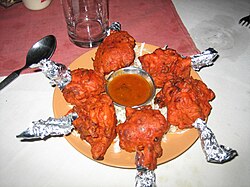 A platter of chicken lollipops, with spicy dipping sauce, served in Goa, India | |
| Type | Starter |
|---|---|
| Course | Hors d'oeuvre |
| Place of origin | India |
| Associated cuisine | Indian |
| Serving temperature | Hot |
| Main ingredients | Chicken wings, batter |
| Variations | Mutton lollipop |
Chicken lollipop is a popular Indian fried chicken appetiser. Chicken lollipop is essentially a frenched chicken winglet, wherein the meat is cut loose from the bone end and pushed down, creating a lollipop appearance. [1]